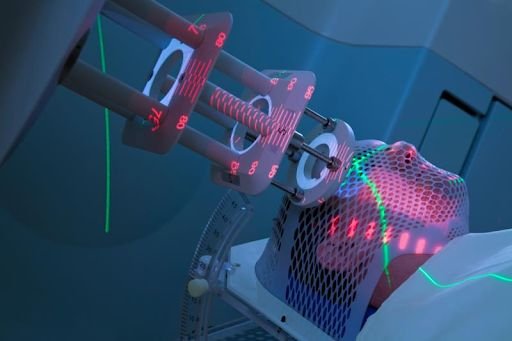Stereotactic radiosurgery is a non-surgical treatment for functional deficits and small brain tumors. Delivering carefully targeted radiation in fewer high-dose sessions than standard therapy can help retain healthy tissues.
Dr. Mohana Rao, one of the best neurosurgeons in Guntur, Andhra Pradesh, collaborates with highly qualified and experienced neurosurgeons at Dr. Rao’s Hospital to ensure that patients receive the care they need, whether it’s emergency care, surgical treatment, cutting-edge diagnostics, and therapeutic interventions, clinical trials, or rehabilitative services.

The benefits of stereotactic radiosurgery (SRS) over traditional techniques are discussed in this article and how SRS treatment can improve quality of life by Dr. Mohana Rao.
To begin, let’s define stereotactic radiosurgery and explain how it works.
Stereotactic radiosurgery is a type of radiation therapy used to treat tumors of the brain and spine and other mental illnesses. During treatment, small, precise doses of radiation are targeted on the brain or spinal cord. Tumors shrink, or abnormal blood vessels and nerves that cause pain and convulsions become blocked.
Stereotactic radiosurgery can be used to treat some brain diseases, such as Parkinson’s disease. Stereotactic Radiosurgery is a potential alternative to neurosurgery for some individuals. It is less invasive and requires less hospitalization and recuperation time than neurosurgery.
Our competent neurosurgeons at Dr. Rao’s Hospital, an acclaimed stereotactic radiosurgery hospital in Andhra Pradesh, may employ stereotactic radiosurgery to treat tumors that are difficult to cure with traditional surgery. Radiation, on the other hand, kills both normal and cancerous cells.

Our surgeons and care team may use specialized equipment and techniques to target the tumor while limiting damage to healthy cells.
For brain and spine tumors and other brain disorders, stereotactic radiosurgery is one therapy option. The Gamma Knife, a non-invasive neurosurgical device, can be used by surgeons to target radiation on brain tumors. According to Dr. Mohana Rao, the best neurosurgeon in Guntur, other difficult-to-treat brain illnesses can also be cured using Gamma Knife radiosurgery.
What is the purpose of stereotactic radiosurgery?
A neurosurgeon may recommend stereotactic radiosurgery to treat the following conditions:
- Acoustic neuroma.
• Arteriovenous malformations (AVMs).
• Brain tumors.
• Some ocular diseases.
• Epilepsy caused by a brain tumor.
• Parkinson’s disease.
• Tumors of the pineal gland.
• Tumors of the pituitary gland.
• Psychoneurosis.
• Tumors of the base of the skull.
• Trigeminal neuralgia.
Furthermore, stereotactic radiosurgery can be utilized to:
- Enhance traditional radiation therapy.
• If past treatments have failed, give patients another option.
• Manage or treat a recurrent spinal tumor.
• After surgery, treat or maintain the tumor’s remaining region.
Is the SRS surgery painful?
Your comfort and relaxation are essential to both you and our care team. The procedure of stereotactic radiosurgery is painless. Children and others who are claustrophobic or have difficulty sitting still in the immobilization device may benefit from sedative medications.

You may feel some pressure while a head frame is being installed on the skull. Medications provided by your doctor may be able to assist you. Some people get a headache or nausea after treatment. Nausea and headache usually go away within a day or two. Tell your doctor or care team if you are uncomfortable in any manner.
After stereotactic radiosurgery, how will I feel?
The majority of adverse effects are minimal and last only a few days. Some patients report feeling well and experiencing no side effects after stereotactic radiosurgery.
Some people report feeling queasy, hungry, or having a headache after surgery. Other minor side effects, such as fatigue and skin irritation, may emerge shortly after surgery.
Your doctor will prescribe medications to help you deal with the adverse effects. Consult your doctor if you’re having trouble coping with side effects.
When will I be allowed to go home again?
After stereotactic radiosurgery, the majority of patients return home the same day. Others, on the other hand, may be kept overnight for observation. Even if you are sedated, you will be dizzy and will most likely require transportation home. You should not drive for at least 24 hours, and someone throughout that time should accompany you.
What advantages can stereotactic radiosurgery provide?
- No hospitalization, surgical cuts, blood loss, or other operative complications.
• Treatment time is less than traditional treatment.
• Tumor growth management is better.
• Treatment is provided from several treatment angles, sparing normal tissue.
Is stereotactic radiosurgery effective in enhancing the quality of life?

SRS has a higher quality of life than standard radiation therapy because it limits radiation exposure to normal brain tissue. According to Dr. Rao, Guntur’s most excellent neurosurgeon, SRS’s cognitive impact is negligible compared to whole-brain radiation therapy.
The drug helps to preserve memory while also reducing the risk of leukoencephalopathy and white matter loss. As a result, there is a lower likelihood of neurobehavioral sluggishness, apathy, poor bilateral fine motor coordination, memory retrieval, and frontal lobe executive dysfunction. The goal is to deliver doses that eliminate the tumor while also providing long-term local control for the patient.







